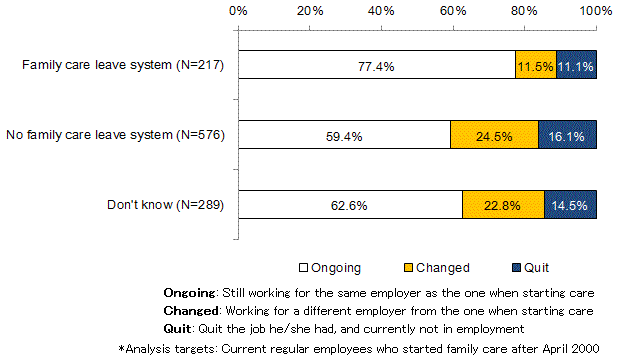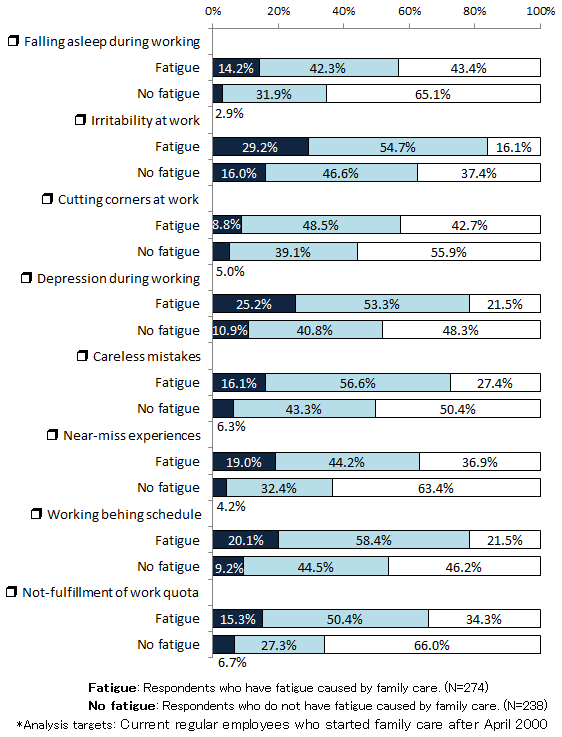Combining Work and Care
May 29, 2015
Summary
Research Objective
For this Research, a survey was conducted to identify the challenges in supporting combining work and family care (such as preventing workers from leaving job for long-term care for sick or disabled family members or relatives) The survey focused on a number of issues, including ways of working while providing care, the situation of utilization of support systems for balancing work and family care, experience of quitting or changing jobs, the situation of care recipients and sharing care burdens with other family members, the use of care services, and the health of carers.
Research Method
Questionnaire survey
Survey Targets
2,000 males and females aged 20-59 who provide long-term care for family members or relatives living together or apart
Main Survey Topics
- The situation when long-term care started (circumstances of care recipients, the respondent’s role in providing care, burdens of care, etc.)
- Work situation when they started care (working hours, relocation, quitting or changing jobs, work-life balance support systems, etc.)
- The current situation of care (circumstances of care recipients, the respondent’s role in providing care, burdens of care, etc.)
- The current work situation (nature of work duties, work performance, work-life balance support systems, etc.)
Survey Method
Distribution and collection of questionnaires (Internet questionnaire survey using respondents registered at the online survey company)
Collection Results
The cooperation of the survey company was requested until 2,000 valid responses had been received. To correct bias in the respondents’ attributes, 2,000 responses were proportionally allocated and collected so that the employment rate and the composition rate by employment type (by gender and age) as well as the occupational distribution (by gender) would approximate the component ratios of persons providing care for family members in the “FY2012 Employment Status Survey” (Ministry of Internal Affairs and Communications).
Survey period
September 19 (Fri.) to October 1 (Wed.), 2014Survey Company
Nippon Research Center, Ltd.Main Findings
- The provision of informal long-term care is an issue involving not only workers in non-regular employment (a common employment type for middle-aged and older women, the traditional carers) but also those in regular employment. This reflects a diversification of carers, such as those caring for their own parents regardless of gender, or younger persons caring for grandparents.
- When the employer has a family-care leave system, the proportion of carers quitting or changing jobs decreases (Figure 1). On the other hand, the need for long-term leave lasting several months is small. Many of the carers are trying to combine work and family care by flexibly adjusting their way of working as necessary, taking short-term leave or holidays, not working overtime, or taking time out during working hours.
Figure 1. Ratio of carers quitting or changing jobs they had when starting care, by presence or absence of family care leave system in the workplace

- Compared to women, men have a more pronounced declining tendency with age for positive attitudes for work and motivation to develop their skills. For working carers to be able to combine work and care while maintaining strong motivation for work, it is important not only to improve work-life balance support systems but also to provide appropriate workplace management by supervisors.
- Even among carers who go to work as usual, fatigue and stress can accumulate as a result of providing care after returning home and on days off. Fatigue and stress arising from providing care have an adverse impact on work in three specific problem areas: work attitude (falling asleep, irritability, or depression during working), work accuracy (careless mistakes, and “near-miss experiences” that could lead to gross negligence and accidents), and work performance (working behind schedule and unfulfilling work quota) (Figure 2).
Figure 2. Ratio of experiences involving reduced work efficiency, by presence or absence of physical fatigue caused by family care

Policy Implications
As tasks for supporting the balance between work and care in future, the following implications were obtained.
- The need to create flexible support systems and ways of working that assist a combining work and family care, including divisible family care leave, exemption from overtime, staggered working hours, and “taking time out” during working hours.
- The need to create schemes that give employers a better understanding of their employees’ situations of family care and thereby address difficulties that have an adverse effect on work (such as reduced work motivation or health problems among carers).
Policy Contribution
Survey results reported at the “4th Meeting of the Working Group on Balancing Work and Family in the Future” on January 23, 2015.
Contents
- JILPT Research Report No.170 whole text (PDF:2.6MB)
If it takes too long to download the whole text, please access each file separately.
- Introduction: Survey Research objective and summary (PDF:451KB)
- Chapter 1: Work and care by working carers
Chapter 2: Carers quitting or changing jobs and employers’ support for balance – With focus on systems of care leave (PDF:826KB) - Chapter 3: Problems of working hours affecting the balance between work and care (PDF:543KB)
- Chapter 4: Work performance attitudes and skill development motivation of employees who balance home-based care with work, and support from employers (PDF:659KB)
- Chapter 5: The impact of working carers’ health on their work Conclusion: Summary and implications (PDF:1.0MB)
- Appendices (PDF:1.6MB)
Research Categories
Project Research:
“Research on Companies’ Employment Systems and Personnel Strategies, Improvement of the Quality of Employment through Development of Employment Rules, and Realization of Decent Work”
Subtheme: “Survey Research on Work and Lifestyles”
Research Period
FY2014
Author
- Shingou IKEDA
- Vice Senior Researcher, The Japan Institute for Labour Policy and Training
- Tomohiro TAKAMI
- Researcher, The Japan Institute for Labour Policy and Training
- Mitsuyo MATSUBARA
- Visiting Fellow, Gakushuin University
Category
Workers' life / Workers' awareness, Working conditions / Work environment, Diversified working styles
JILPT Research Report at a Glance
| To view PDF files, you will need Adobe Acrobat Reader Software installed on your computer.The Adobe Acrobat Reader can be downloaded from this banner. |

